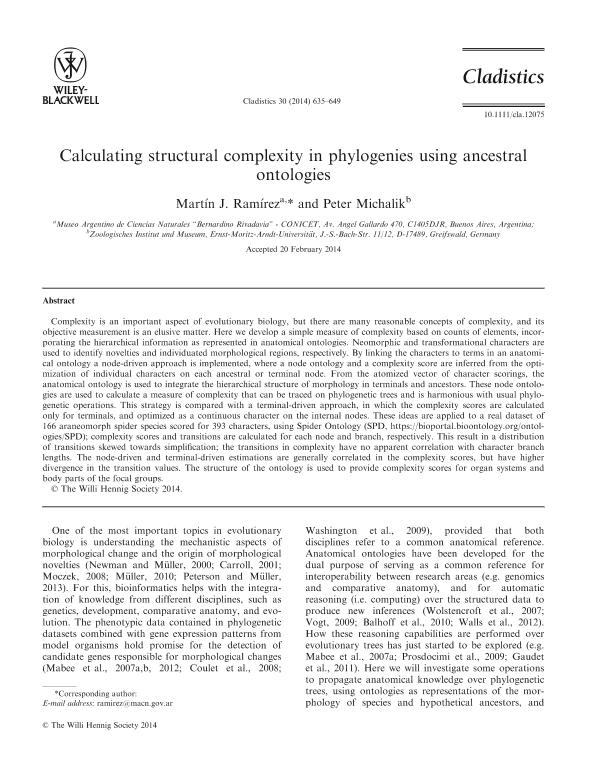Mostrar el registro sencillo del ítem
dc.contributor.author
Ramirez, Martin Javier

dc.contributor.author
Michalik, Peter

dc.date.available
2017-06-13T21:01:08Z
dc.date.issued
2014-04-22
dc.identifier.citation
Ramirez, Martin Javier; Michalik, Peter; Calculating structural complexity in phylogenies using ancestral ontologies; Wiley Blackwell Publishing, Inc; Cladistics; 30; 6; 22-4-2014; 635-649
dc.identifier.issn
0748-3007
dc.identifier.uri
http://hdl.handle.net/11336/18148
dc.description.abstract
Complexity is an important aspect of evolutionary biology, but there are many reasonable concepts of complexity, and its objective measurement is an elusive matter. Here we develop a simple measure of complexity based on counts of elements, incorporating the hierarchical information as represented in anatomical ontologies. Neomorphic and transformational characters are used to identify novelties and individuated morphological regions, respectively. By linking the characters to terms in an anatomical ontology a node-driven approach is implemented, where a node ontology and a complexity score are inferred from the optimization of individual characters on each ancestral or terminal node. From the atomized vector of character scorings, the anatomical ontology is used to integrate the hierarchical structure of morphology in terminals and ancestors. These node ontologies are used to calculate a measure of complexity that can be traced on phylogenetic trees and is harmonious with usual phylogenetic operations. This strategy is compared with a terminal-driven approach, in which the complexity scores are calculated only for terminals, and optimized as a continuous character on the internal nodes. These ideas are applied to a real dataset of 166 araneomorph spider species scored for 393 characters, using Spider Ontology (SPD, https://bioportal.bioontology.org/ontologies/ SPD); complexity scores and transitions are calculated for each node and branch, respectively. This result in a distribution of transitions skewed towards simplification; the transitions in complexity have no apparent correlation with character branch lengths. The node-driven and terminal-driven estimations are generally correlated in the complexity scores, but have higher divergence in the transition values. The structure of the ontology is used to provide complexity scores for organ systems and body parts of the focal groups.
dc.format
application/pdf
dc.language.iso
eng
dc.publisher
Wiley Blackwell Publishing, Inc

dc.rights
info:eu-repo/semantics/openAccess
dc.rights.uri
https://creativecommons.org/licenses/by-nc-sa/2.5/ar/
dc.subject
Anatomical Ontology
dc.subject
Systematics
dc.subject
Automated Reasoning
dc.subject.classification
Zoología, Ornitología, Entomología, Etología

dc.subject.classification
Ciencias Biológicas

dc.subject.classification
CIENCIAS NATURALES Y EXACTAS

dc.title
Calculating structural complexity in phylogenies using ancestral ontologies
dc.type
info:eu-repo/semantics/article
dc.type
info:ar-repo/semantics/artículo
dc.type
info:eu-repo/semantics/publishedVersion
dc.date.updated
2017-06-06T18:45:38Z
dc.journal.volume
30
dc.journal.number
6
dc.journal.pagination
635-649
dc.journal.pais
Reino Unido

dc.journal.ciudad
Londres
dc.description.fil
Fil: Ramirez, Martin Javier. Consejo Nacional de Investigaciones Científicas y Técnicas. Oficina de Coordinación Administrativa Parque Centenario. Museo Argentino de Ciencias Naturales "bernardino Rivadavia"; Argentina
dc.description.fil
Fil: Michalik, Peter. Ernst-Moritz-Arndt-Universität. Zoologisches Institut Und Museum; Alemania
dc.journal.title
Cladistics

dc.relation.alternativeid
info:eu-repo/semantics/altIdentifier/doi/http://dx.doi.org/10.1111/cla.12075
dc.relation.alternativeid
info:eu-repo/semantics/altIdentifier/url/http://onlinelibrary.wiley.com/doi/10.1111/cla.12075/abstract
Archivos asociados
